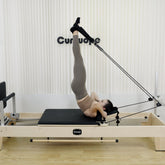How does Pilates Reformer compare to running for working out?
Pilates Reformer and running are two very different forms of exercise that offer unique benefits to the body. While running is a high-impact aerobic exercise that primarily focuses on cardiovascular fitness, Pilates Reformer is a low-impact form of exercise that targets strength, flexibility, and balance.

In terms of calorie burn, running is a more effective way to burn calories as it is a high-intensity exercise that raises the heart rate and increases metabolism. According to Harvard Health, a person weighing 155 pounds can burn around 372 calories by running at a moderate pace for 30 minutes. On the other hand, Pilates Reformer exercises burn fewer calories as they are low-impact and focus on controlled movements rather than intensity.
However, Pilates Reformer offers several unique benefits that running does not. Pilates Reformer exercises improve core strength, which helps to improve posture, balance, and stability. The exercises also target specific muscle groups, including the glutes, abs, and back, which can help to prevent injuries and improve overall body function. Pilates Reformer is also a low-impact form of exercise that is easy on the joints, making it a good choice for people with joint pain or injuries.
Here are some key differences between Pilates Reformer and running:
Impact: Running is a high-impact exercise that puts a lot of stress on the joints, especially the knees and ankles. Pilates Reformer, on the other hand, is a low-impact exercise that is gentle on the joints and suitable for people of all fitness levels.
Cardiovascular Benefits: Running is a great form of cardiovascular exercise that can help to improve heart health and endurance. Pilates Reformer, while not a traditional cardio exercise, can still provide cardiovascular benefits by keeping the heart rate elevated and promoting circulation.
Strength and Tone: Pilates Reformer is a full-body workout that emphasizes strength, flexibility, and alignment. It targets the core, legs, arms, and back, and can help to improve muscle tone and definition. Running primarily works the lower body, specifically the quadriceps, hamstrings, and calves.
Flexibility: Pilates Reformer incorporates a variety of stretching exercises that help to improve flexibility and mobility. Running, while it can help to loosen up tight muscles, does not provide the same level of targeted stretching as Pilates Reformer.
Mind-Body Connection: Pilates Reformer places a strong emphasis on the mind-body connection, encouraging participants to focus on their breath and movement patterns. Running, while it can be meditative, does not have the same level of mindfulness as Pilates Reformer.
In conclusion, both Pilates Reformer and running have their unique benefits and can be effective forms of exercise. While running is a more effective way to burn calories and improve cardiovascular fitness, Pilates Reformer offers benefits such as improved core strength, joint health, and mind-body awareness. Ultimately, the choice between Pilates Reformer and running depends on an individual's fitness goals, preferences, and physical limitations. It is also worth noting that a combination of both exercises can provide a well-rounded and balanced workout routine.





